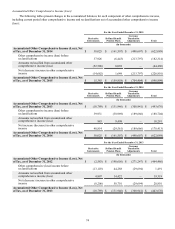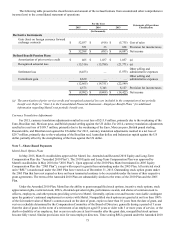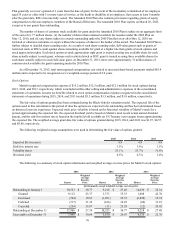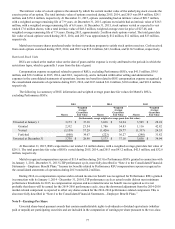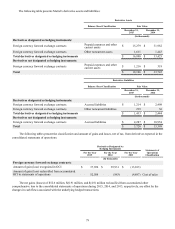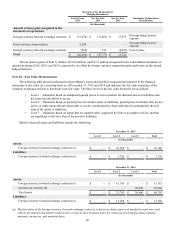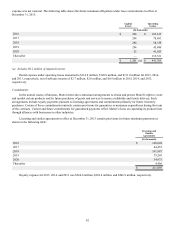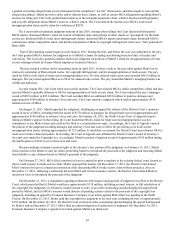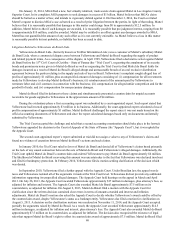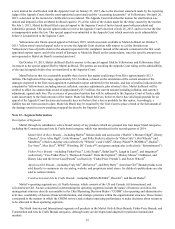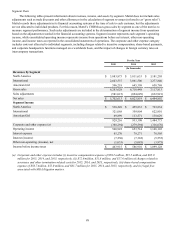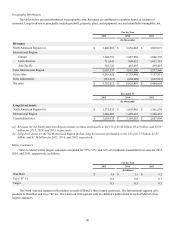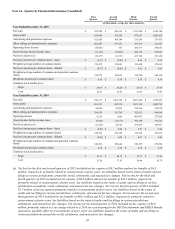Mattel 2015 Annual Report Download - page 88
Download and view the complete annual report
Please find page 88 of the 2015 Mattel annual report below. You can navigate through the pages in the report by either clicking on the pages listed below, or by using the keyword search tool below to find specific information within the annual report.84
On January 12, 2007, Mattel filed an Amended Complaint setting forth counterclaims that included additional claims
against Bryant as well as claims for copyright infringement, Racketeer Influenced and Corrupt Organizations (“RICO”)
violations, misappropriation of trade secrets, intentional interference with contract, aiding and abetting breach of fiduciary duty
and breach of duty of loyalty, and unfair competition, among others, against MGA, its Chief Executive Officer Isaac Larian,
certain MGA affiliates and an MGA employee. The RICO claim alleged that MGA stole Bratz and then, by recruiting and
hiring key Mattel employees and directing them to bring with them Mattel confidential and proprietary information, unfairly
competed against Mattel using Mattel’s trade secrets, confidential information, and key employees to build their business.
Mattel sought to try all of its claims in a single trial, but in February 2007, the Court decided that the consolidated cases
would be tried in two phases, with the first trial to determine claims and defenses related to Mattel’s ownership of Bratz works
and whether MGA infringed those works. On May 19, 2008, Bryant reached a settlement agreement with Mattel and is no
longer a defendant in the litigation. In the public stipulation entered by Mattel and Bryant in connection with the resolution,
Bryant agreed that he was and would continue to be bound by all prior and future Court Orders relating to Bratz ownership and
infringement, including the Court’s summary judgment rulings.
The first phase of the first trial resulted in a unanimous jury verdict on July 17, 2008 in favor of Mattel. The jury found
that almost all of the Bratz design drawings and other works in question were created by Bryant while he was employed at
Mattel; that MGA and Isaac Larian intentionally interfered with the contractual duties owed by Bryant to Mattel, aided and
abetted Bryant’s breaches of his duty of loyalty to Mattel, aided and abetted Bryant’s breaches of the fiduciary duties he owed
to Mattel, and converted Mattel property for their own use. The same jury determined that defendants MGA, Larian, and MGA
Entertainment (HK) Limited infringed Mattel’s copyrights in the Bratz design drawings and other Bratz works, and awarded
Mattel total damages of approximately $100 million against the defendants. On December 3, 2008, the Court issued a series of
orders rejecting MGA’s equitable defenses and granting Mattel’s motions for equitable relief, including an order enjoining the
MGA party defendants from manufacturing, marketing, or selling certain Bratz fashion dolls or from using the “Bratz” name.
The Court stayed its December 3, 2008 injunctive orders until further order of the Court.
The parties filed and argued additional motions for post-trial relief, including a request by MGA to enter judgment as a
matter of law on Mattel’s claims in MGA’s favor and to reduce the jury’s damages award to Mattel. Mattel additionally moved
for the appointment of a receiver. On April 27, 2009, the Court entered an order confirming that Bratz works found by the jury
to have been created by Bryant during his Mattel employment were Mattel’s property and that hundreds of Bratz female fashion
dolls infringe Mattel’s copyrights. The Court also upheld the jury’s award of damages in the amount of $100 million and
ordered an accounting of post-trial Bratz sales. The Court further vacated the stay of the December 3, 2008 orders.
MGA appealed the Court’s equitable orders to the Court of Appeals for the Ninth Circuit. On December 9, 2009, the
Ninth Circuit heard oral argument on MGA’s appeal and issued an order staying the District Court’s equitable orders pending a
further order to be issued by the Ninth Circuit. On July 22, 2010, the Ninth Circuit vacated the District Court’s equitable orders.
The Ninth Circuit stated that, because of several jury instruction errors it identified, a significant portion—if not all—of the
jury verdict and damage award should be vacated.
In its opinion, the Ninth Circuit found that the District Court erred in concluding that Mattel’s Invention Agreement
unambiguously applied to “ideas;” that it should have considered extrinsic evidence in determining the application of the
agreement; and if the conclusion turns on conflicting evidence, it should have been up to the jury to decide. The Ninth Circuit
also concluded that the District Judge erred in transferring the entire brand to Mattel based on misappropriated names and that
the Court should have submitted to the jury, rather than deciding itself, whether Bryant’s agreement assigned works created
outside the scope of his employment and whether Bryant’s creation of the Bratz designs and sculpt was outside of his
employment. The Court then went on to address copyright issues which would be raised after a retrial, since Mattel “might well
convince a properly instructed jury” that it owns Bryant’s designs and sculpt. The Ninth Circuit stated that the sculpt itself was
entitled only to “thin” copyright protection against virtually identical works, while the Bratz sketches were entitled to “broad”
protection against substantially similar works; in applying the broad protection, however, the Ninth Circuit found that the lower
court had erred in failing to filter out all of the unprotectable elements of Bryant’s sketches. This mistake, the Court said,
caused the lower court to conclude that all Bratz dolls were substantially similar to Bryant’s original sketches.
Judge Stephen Larson, who presided over the first trial, retired from the bench during the course of the appeal, and the
case was transferred to Judge David O. Carter. After the transfer, Judge Carter granted Mattel leave to file a Fourth Amended
Answer and Counterclaims which focused on RICO, trade secret and other claims, and added additional parties, and
subsequently granted in part and denied in part a defense motion to dismiss those counterclaims.
Later, on August 16, 2010, MGA asserted several new claims against Mattel in response to Mattel’s Fourth Amended
Answer and Counterclaims, including claims for alleged trade secret misappropriation, an alleged violation of RICO, and
wrongful injunction. MGA alleged, in summary, that, for more than a decade dating back to 1992, Mattel employees engaged in


